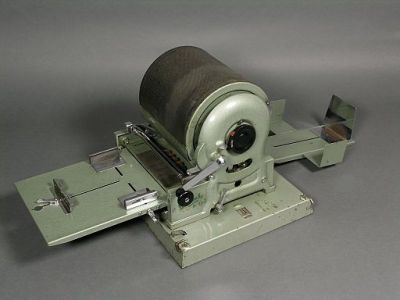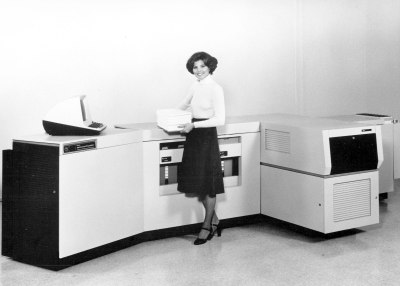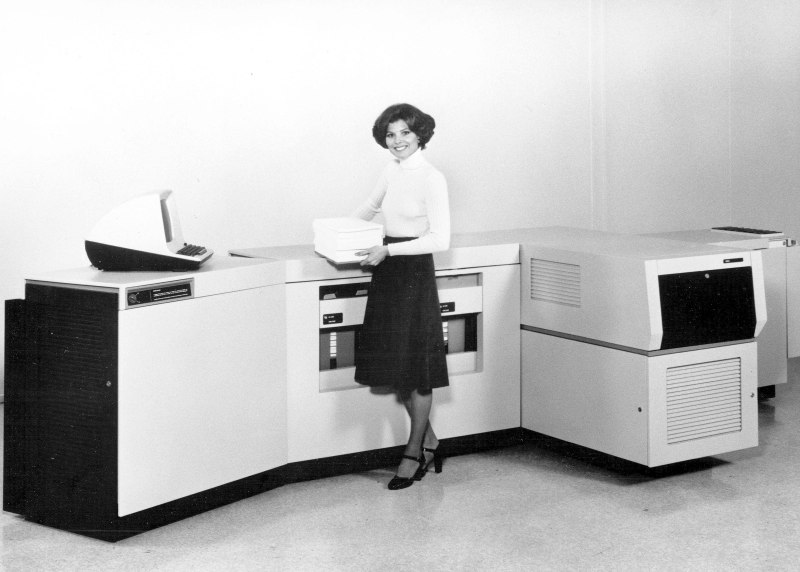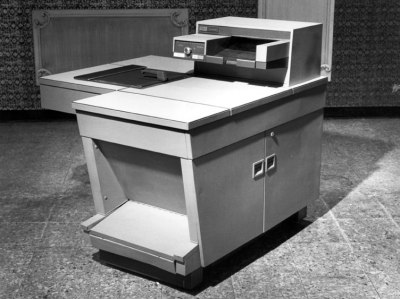It seems hard to imagine, but in the early part of the 20th century, there weren’t a lot of great options for creating copies of documents. The most common method was to use carbon paper to create multiple copies at once from a typewriter or a line printer. All that changed with a company called Haloid. Never heard of them? They later became the Xerox company.
The underlying technology dates back to 1938 (invented by a physicist who was also a lawyer). In 1944, they produced a practical copier and shortly thereafter sold the rights to Haloid. The Haloid company originally made photographic copy machines that used wet chemistry.
In 1959, the Xerox 914 (so called because it could copy a 9″ x 14″ document) came on the scene (that’s it, below). The 650 pound copier could make seven copies per minute and came with a fire extinguisher because it had a tendency to burst into flames. If you didn’t want to spend the $27,500 price tag, you could rent for only $25/month (keep in mind that in 1959, $25 would buy about 25 pounds of T-bone steaks). You can see a commercial for the 914 in the video below.
In the commercial, you’ll see them make a big deal out of the fact that the print was dry. That’s because a lot of previous machines used actual photographic processes with wet chemistry. Obviously, that also took special paper.
Even Further Back
If the copier didn’t exist until recently, how did people make copies before? Turns out there were lots of ways to make copies of varying degrees of bad quality or extreme trouble. In some sense, the best copies were made by scribes just writing down a second copy of things. There were a variety of machines that would capture what you wrote and make a copy by mechanical or other means. A polygraph (not the lie detecting kind) allowed Thomas Jefferson to write letters and make a copy. The machine moved a pen to match the movements of the author’s pen, thus making a near perfect copy. With a few adjustments, this became the pantograph which not only does the same job, but also can shrink or enlarge the copy. Carbon paper was widely used to make multiple copies of handwritten and typewritten documents.

If you were willing to make a “master” to produce copies, you had even more options. Schools used to use hectographs (gelatin in a pan) to soak up ink from a master and then transfer it to paper using a wet process that left the paper swollen and crinkly. Real printers might make plates out of metal or wood. The duplicator (see right) was another popular office machine. A typewriter would cut a wax stencil. The wax contained an ink and a solvent (alcohol) would transfer the ink to the paper.
All this is just the tip of the iceberg. If you really want to dive into how people produced documents, Wikipedia has a list.
Cause and Effect

Consider this: Early computer printers were basically typewriters of one sort or another. Sure, some printers used chains and bands and daisy wheels and type balls. Some printers used just a few dots to form letters instead of type elements, but they still employed something striking a ribbon and hitting the paper.
The Xerox machine took a different approach. It charged a drum that picked up toner and pressed it on paper. At the time, it must have seemed obvious that the drum was photosensitive and “scanned” the original. But the real power would be in having a computer lay down the light using a LASER or LED light.
Not to say the original copier wasn’t a breakthrough. But a bigger breakthrough was waiting behind it. Xerox did that breakthrough, as well. [Gary Starkweather] had the notion in 1969 and converted a Xerox 7000 into a laser printer in 1971. A commercial printer had to wait for the IBM 3800 in 1976. The 240 DPI printer used continuous paper like a regular line printer and could produce 215 pages a minute. The Xerox 9700 in 1977 was a bit more like a modern LASER printer, although Canon would bring the technology to the desktop in 1979. The Xerox Star had such a printer in 1981 and the HP LaserJet–which used the Canon technology–appeared in 1984.
As a side note, the Xerox 9700 source code was not available to users. This made the MIT AI Lab unhappy as they had previously modified printer source code to do things like alert users when jobs printed. One user, in particular, was especially unhappy and started thinking about why software should be open. That user? [Richard Stallman]. You could argue that the Xerox 9700 launched the free software movement.
















Ditto and Gestetner masters, and indeed one off copies of a plain document could be made with a 3M Thermofax among other things and this often forgotten machine was a key bit of gear in many school print rooms in the pre Xerox era
All hail the Risograph!
My elementary school had one, had these weird plastic ink cartridges that went into it. Once one of the student aides dropped one and the cap popped off and the ink went everywhere, made more of a mess than toner.
The mechanical simplicity of a pantograph makes it a neat project in itself.
https://en.wikipedia.org/wiki/Pantograph
You could take a picture with a camera. This was common in spy movies, nice and fast and portable. Also used in microfilm, condense a lot of paper into a roll of film.
Ironically, now that anyone can have a scanner, and a printer, they also have digital cameras, which makes the process fast and easy.
Michael
Why choose between a camera or a photocopier, why not use both…
http://electricalstrategies.com/about/in-the-news/spies-in-the-xerox-machine/
https://www.youtube.com/watch?v=AwdRYgEv76s
>>If you didn’t want to spend the $27,500 price tag, you could rent for only $25/month
How did they make money on that? At $25 a month they would have to rent it out for 91 Years to break even on the purchase price.
They presumably saw a better business model in getting users hooked on having one. Just like buying a phone plan gets you a significantly cheaper phone.
I don’t know the prices in US, but over here (in Poland) it doesn’t work out cheaper. I did math on every single phone offered by every major provider, phone with contract vs sim-only equivalent contract and unlocked phone from the store. Unlocked phone was consistently 20% cheaper over the time of the contract.
cost per copy agreement.. cheap rental but stitch them up on copies cost. They could have broken even in under the year in the right location, certainly not even 9 years!
Handle, meet razor blade. Razor blade, handle.
They sold it for 27K, that was not what they needed to invest into making one surely. So if making one costs only 20% then renting it out can be done ‘cheap’.
Mimeograph. Those purple handouts I saw inclass.
I forgot the synonyms – it is a spirit copier, and was also known as a “Ditto Machine”
We had a Ditto machine in grade school and I’m not even that old! I kind of miss that blue font on white paper.
Ours were always a shade of purple instead of blue, regardless of which school I attended. Must have all had the same ink supplier.
They called ours a “Bandagraph” or “Banda”, had entirely forgotten about them until now! The pale blueish tone, ah school nostalgia hahaha
The purple ones that everybody sniffed were from a spirit duplicator, aka “Ditto” machine. It worked by using a pigmented wax that stuck to the back side of the master when you either typed or wrote on it. The duplicator machine then sprayed a solvent onto it that softened a thin layer of the wax, allowing it to transfer to the paper. Every schoolkid was addicted to the solvent. Ditto was only good for a limited number of copies because once all of the wax was gone, that was that.
Mimeograph was a different process that used a wax-coated master. Typing on this fractured the wax and let ink through on the printing machine. Many more copies were possible but these were of lower quality because the ink did not fracture evenly.
Yes, that’s more than anybody asked.
I was in college at just the right time to have cut ditto masters on a daisy wheel printer attached to a computer.
ROFL!!!
I printed them on a 9-pin printer – in NLQ mode for better density – at the Commodore 64 during the last school years at about 17. Much better then hand writing or my mothers mechanical typewriter, because you could do corrections, before you use the wax coated paper.
I loved the smell of mimeographed papers in grade school in the 70’s. Could also draw on the master sheets and make copies.
Different colors of ink were available but for some reason the school I went to only used purple.
I remember cranking them off for my teacher in 6th grade. About every 40 copies a page would violently origami itself into the mechanism. OTOH our SF ‘Zine I worked on in high school was a classic xerox production. Still have a few copies of “The Alien Quack” laying about…
Xerox was also an original patent exploiter if not actual troll – they got the original electrographic patent, but then would patent something new every few years until a bit of “You are really pushing your monopoly” talk from the Government.
Hah! That takes me back to college. There was a huge Xerox(r) machine in the corridor, but you had to go and beg the secretary for the counter, which acted as a key (machine wouldn’t work without it plugged in) and was checked every month by Xerox for billing.
Yeah. So I found a surplus company selling old counters. Plugged one in and the copier didn’t work. There was a 6-pin plug on the back of the counter. Out comes the ohmmeter…measure between pins on the known working counter and on my surplus one. Find that different pins are shorted. Open my counter (two screws with epoxy poured over them) and fire up the soldering iron, move one obvious jumper wire on the connector. Plug in. Test. Free copies for the remainder of my college career :-)
Was that really all those were? If only I’d known!
I can remember making one of those at school and using it to get free photocopies. It really was two or three pins shorted or connected to an electromechanical counter.
Two words:
Logitech ScanMan
I might as well ‘bump’ this post.
It’s a program that prints out a hard copy of data for retrieval using a scanner.
http://hackaday.com/2016/05/29/dragging-teletypes-into-the-21st-century/#comment-3037191
I’m still curious how well the program works; haven’t tried it out yet.
P.S. It’s open-source.
Some businesses still will print out invoices, quotes and other papers, then scan them to PDF to attach to e-mails. WTH? Get with the late 90’s already! Just “print” the documents to PDF directly.
Even worse is when one division of a company prints a document then runs that through a FAX machine. The receiving division gets it on a FAX machine that prints it, then it’s scanned to an image to attach to an e-mail. If they’re going to insist on continuing to FAX stuff, at least they could get FAX modems at each end to keep things digital all the way and quit wasting employee time on handling paper.
I work in the tech sector and still do this because it’s what the local government requires.
Invoices are printed on special 3-ply carbon copy paper by a dot matrix printer. One copy is for the government, one is for the customer, and one is for your records. The invoice paper is numbered, registered with, and usually purchased from the government.
When you get audited, the first thing they check is if there are any physically missing invoices. The only way to comply is to do exactly the weird thing you’re describing.
Anyway I hate it too (guess what happens when a customer loses an invoice? Spoiler: you call your lawyer), but thought it might be interesting to share at least one reason companies get stuck with these bizarre practices.
I do love the way that old dot matrix printer sounds though.
I did this just days ago. Why? because I had to sign the paper.
Of course theoretically I could fake the signature with a copy from any document’s signature I have access to. But in spite of that, emailed scans of physically signed documents are accepted very often. Which is of course way more convenient than having to send the physical paper document through slow and expensive snail-mail.
obligatory:
secret life of the copy machine
(from tim hunkin’s incredible series from the late 80s)
Okay, but the important question is… When was the first butt print made, and who was the first model?
Likely made the first Friday evening following the creation of the first working prototype. As with so many great moments in history: “Hey, hold my beer and watch this!”
IIRC it was Hermann Goering who made one in invisible ink on that munich agreement paper Chamberlain was waving at the airport.
The earliest system for copying technical documentation goes back about 1000 years in China where medical texts were carved into stone slabs so that people could make copies by rubbing the slab with ink and then taking an imprint of the text using a sheet of thin paper that was rubbed onto the stone over the ink then peeled off.
see, “Knowledge and Text Production in an Age of Print: China, 900-1400” ISBN: 9789004192287
The method is demonstrated in the video on the following page at the 2:40 mark.
http://www.cpr.cuhk.edu.hk/cutv/detail/645?t=the-bei-shan-tang-legacy-rubbings-of-stone-engraving-and-model-calligraphy-exhibition
The video show a different (better?) method where the paper is so thin that it can be pressed into the stone so that it is possible to ink it from the front.
Jesus…
Years ago I had a job to make copies of old media (usually paper, but sometimes video or audio) of varying ages and types. As a result they had five paper copiers of different capabilities. One was the size of a dinner table and could do color copies blue prints and maps at full size. Another could be fed a spool of paper and make continuous copies of… you guessed it… media on spools.
There was one copier however, only a couple of years older than the others, with a grungy yellow sign that simply said, “DO NOT USE”. It was just a few feet from my cubicle. It was a full capability copier that could make color copies, inversions, resizing whatever you wanted. It just didn’t have networking capabilities (its younger sexy sister had those features). One day I found out why the sign was there. For two days I was assigned to make copies of old reproduction papers covered in an oily substance that got everything. On the copier, my clothes, everything. I had to handle the clean paper carefully to avoid contamination.
After it was all said and done it took hours to clean up the mess.
IT SUCKED….
I don’t recall which technology made the originals. I did find some old flyers for it, I just can’t recall what it was.
Hi all, stopping by a long time after comments’ war I thought this would have come out, but hey, here it is !
Have you heard about The Secret Life of Machines ? Very great show, and they have one about the copier (https://www.youtube.com/watch?v=S2NIAD5qn7E), you should definitely check it out !
Have a nice (hacka)day :)
Someone needs to do a crowdfunding campaign to buy the original film masters of the show so that new transfers to digital can be made.
The PAL and NTSC DVD sets were made from the original broadcast magnetic tapes, already one generation off from the films. Whomever did the digitizing for DVD didn’t fully review them and “The Car” episode has a bad synch problem in its later part, starting where Tim is at the repair shop. Both the NTSC and PAL DVDs have that and all the online copies were ripped from the DVDs.
So unless someone has a good off-air VHS or Beta tape recording of that episode, the only way to get a good one will be to start from the start.
Tim Hunkin told me by e-mail that it would cost $16K to get the films. Didn’t say if that was for all or per-episode.
A new DVD and Blu-Ray release would be very nice, plus getting a good copy of “The Car” episode out for download.
I bought a set of Titanic documentaries out of the bargain bin at Best Buy once for $5, had three disks (One was about the ship itself and the disaster, one was about the search for the wreck and the discovery, the third was interview with survivors and such) and I think all three discs were recorded on VHS off of the Discovery Channel in the early 90s and that was the copy that they made the DVDs from, as aside from the horrible image quality they had dropouts and static and such, I swear one of the discs even has the “PLAY” in the upper corner of the image at the start of it…
Used to have a 3M desktop copier back in the 1970’s. Did some googling and found the 3M 051, but I recall it looking a bit different, though about the same size. It used special pink sheets, each only usable for a single copy. I think it also needed special paper. Nothing showed up on the pink sheets at any time, they didn’t look changed but the definitely were not reusable. Tried it but for a second pass the paper came out blank.
Sounds like a diazo machine: https://en.wikipedia.org/wiki/Whiteprint
No you are thinking about a 3M Thermofax
https://en.wikipedia.org/wiki/Thermofax
Some 20 or 25 years ago I had a an – already at this times old – wet chemical copier. It was about 60cm*30cm and 20cm high (very rough estimation from memory) used two kinds of special paper, a light yellow one and a white one. You had to stack this two papers with the original and put this into a slit where it was pulled around a drum which contained a green fluorescent tube for exposure. Then you opened the cover. That pressed a fluid filled pouch to squeeze the developer/fixating fluid into a small tub. Then another drum pulled the two special papers through the fluid while pressing the papers together. After that you had to wait the right time to separate the two papers and the yellow one carroied a negative and the white one carried the positive image.
Strangely enough you did not have to keep the papers in the dark during handling and the tube did not emit UV light.
Does anyone have any idea how this was called, or who could have been the manufacturer or how it worked? The device is torn down long ago, as I got only very few sheets of the paper necessary to operate it.
Sounds like a Kodak Verifax copier
https://en.wikipedia.org/wiki/Verifax_copier
although Agfa’s Copyrapid and Gevaert’s Gevacopy used the same process.
Thank you. Yes that fits. I tried to find it already some time ago, but obviously wikipedia is still developing. :-)
I have very fond memories of a machine at university. It didn’t scan, it has a fixed lens a long way down inside and two of the longest flash tubes I’ve ever seen in my life. A dull popping sound and the kind of the light you never look into a second time.
Remember the blind woman in “Night Court?” Fastest on the copier of anyone in the entire building. Didn’t have to stop to close the lid.
Ha! That would do it. Sounds like a potentially funny scene. Not a series I know, might not even have aired in the UK. I did wonder about welders goggles that darken during the arc to achieve the same result at the time.
Another copier I had was large, quite long. All metal housing. Cream colored with a red side panel. All the corners and edges with a 45 degree bevel. Don’t recall the brand name.
It took forever to get going from a dead stop because it had a pad in the bottom with a fluid that would ooze up from a spot in its center and before making copies the whole pad had to be wet.
At least it used plain paper. Soon as we could afford a dry type of copier, that one went buh-bye. IIRC there was a jug of the liquid but we never had to add any.
Some years later (circa 1998) I picked up an example of the second model of flatbed scanner Hewlett Packard made. Freebie! Turned out it required a very special, very proprietary type of parallel port controller. Ouch.
Some patient hunting online found one of them for cheap, the replacement version which worked with both the first model 1 bit scanner and the second model greyscale scanner. Many of those controllers ended up separated from their scanners by clueless people moving out old computers. IIRC there was nothing on the card bracket to indicate it was anything but a normal LPT port.
Then I needed the software. Not on the US HP site. Canada? Noope! Not on any of the English speaking countries HP sites. IIRC I finally dug it up on their Indian site after I’d found a document with the file names. The software was for Windows 3.1.
So I did what any nerd would do. Dug up an old 386 or 486, installed Windows 3.1 along with an old printer then configured the software’s copier mode. Put something on the scanner, click a button and a copy comes out the printer.
Was it a SCSI port? A lot of scanners used SCSI back then. Did it look like any of these? https://en.wikipedia.org/wiki/SCSI_connector
I have some very old SCSI stuff and out of curiosity I once looked if they still sold SCSI adapters, and they did, but they were STILL very expensive, even when with modern technology when you should be able to make and sell them for $5.
I guess the same patent trolls are still sitting on it.
But hey, gives you an excuse to hack one together yourself from an arduino am I right?
It is a simple scales of economy issue, there is no significant market for the devices (these days) and therefore they never benefited from the cost deflation that most technology has.